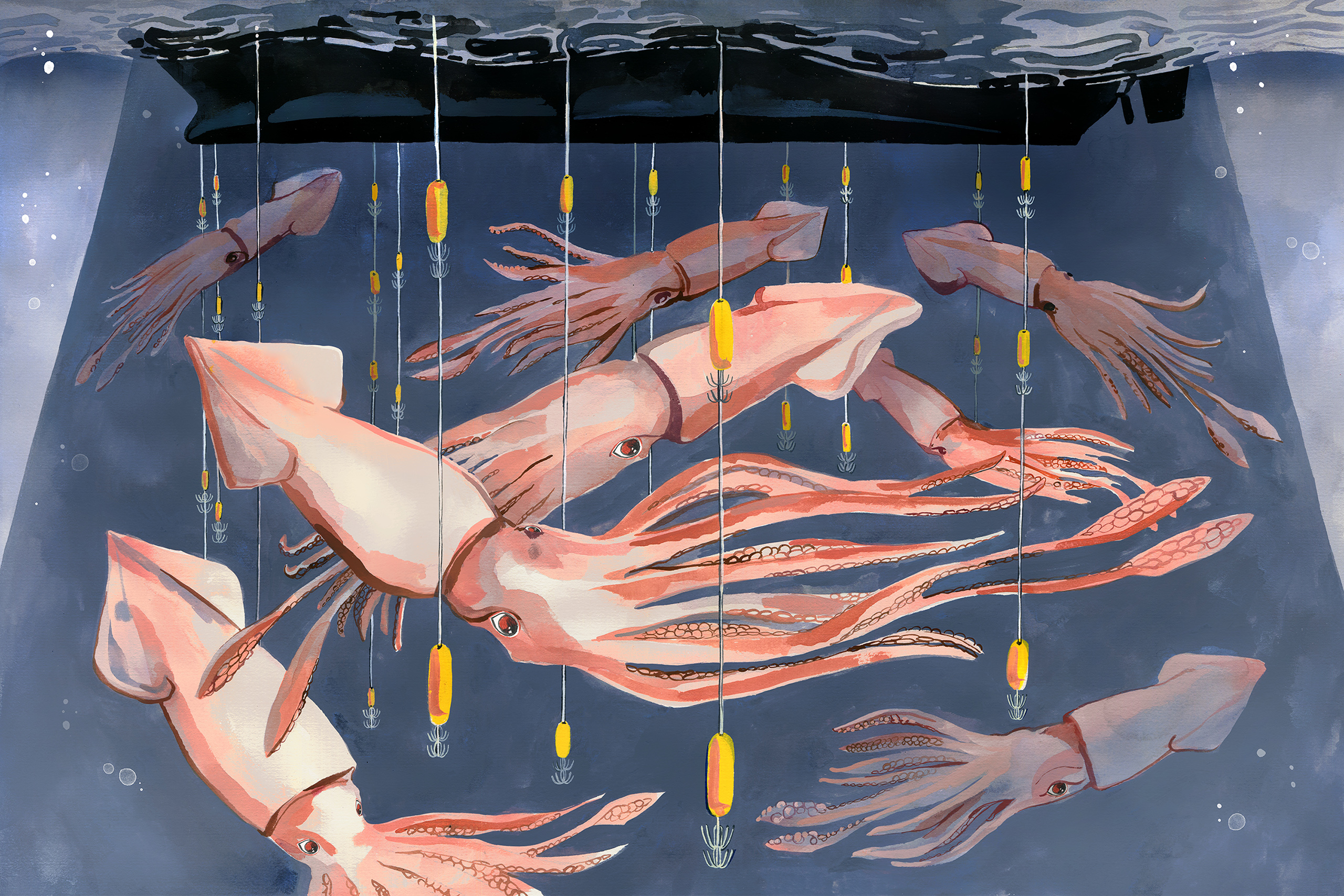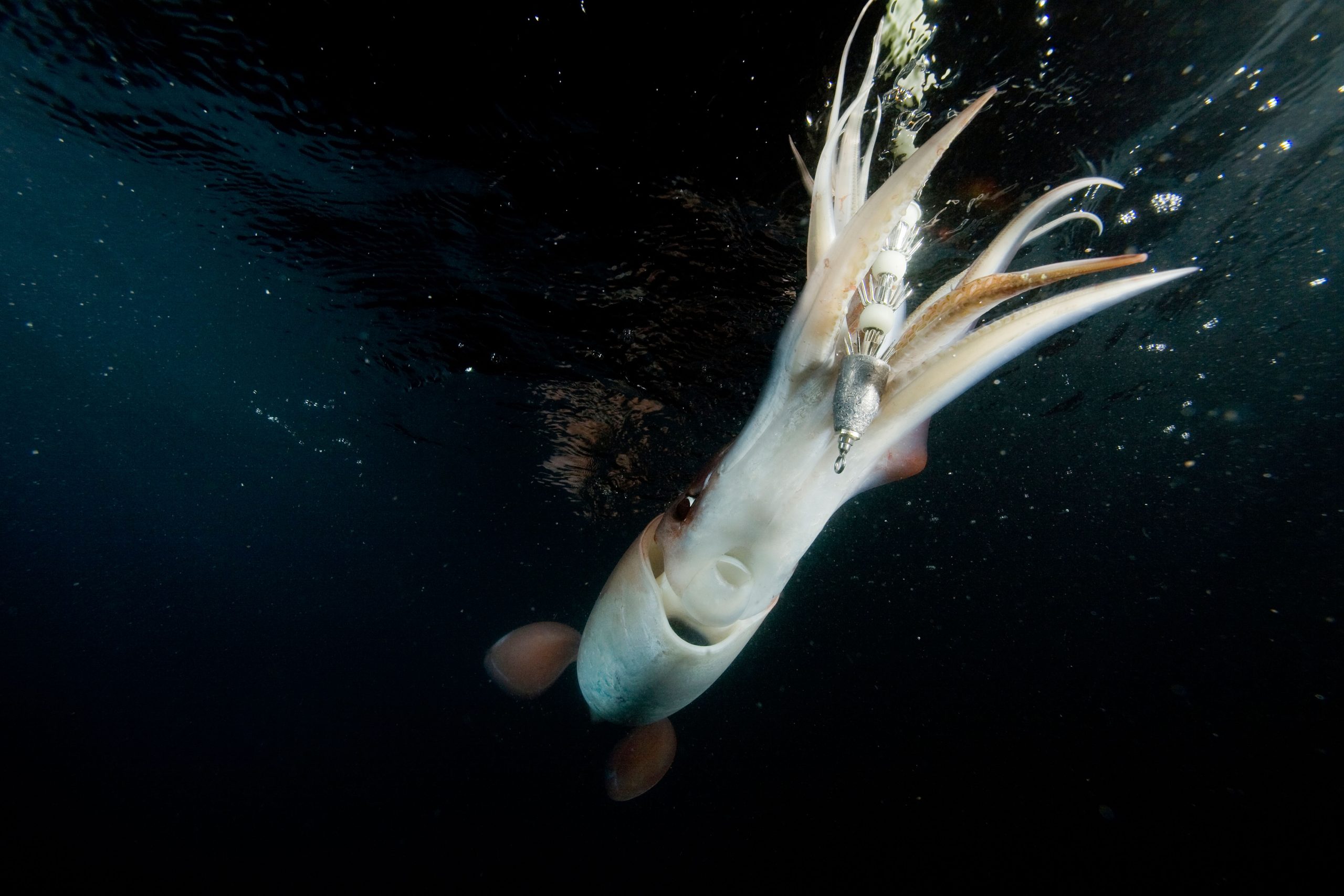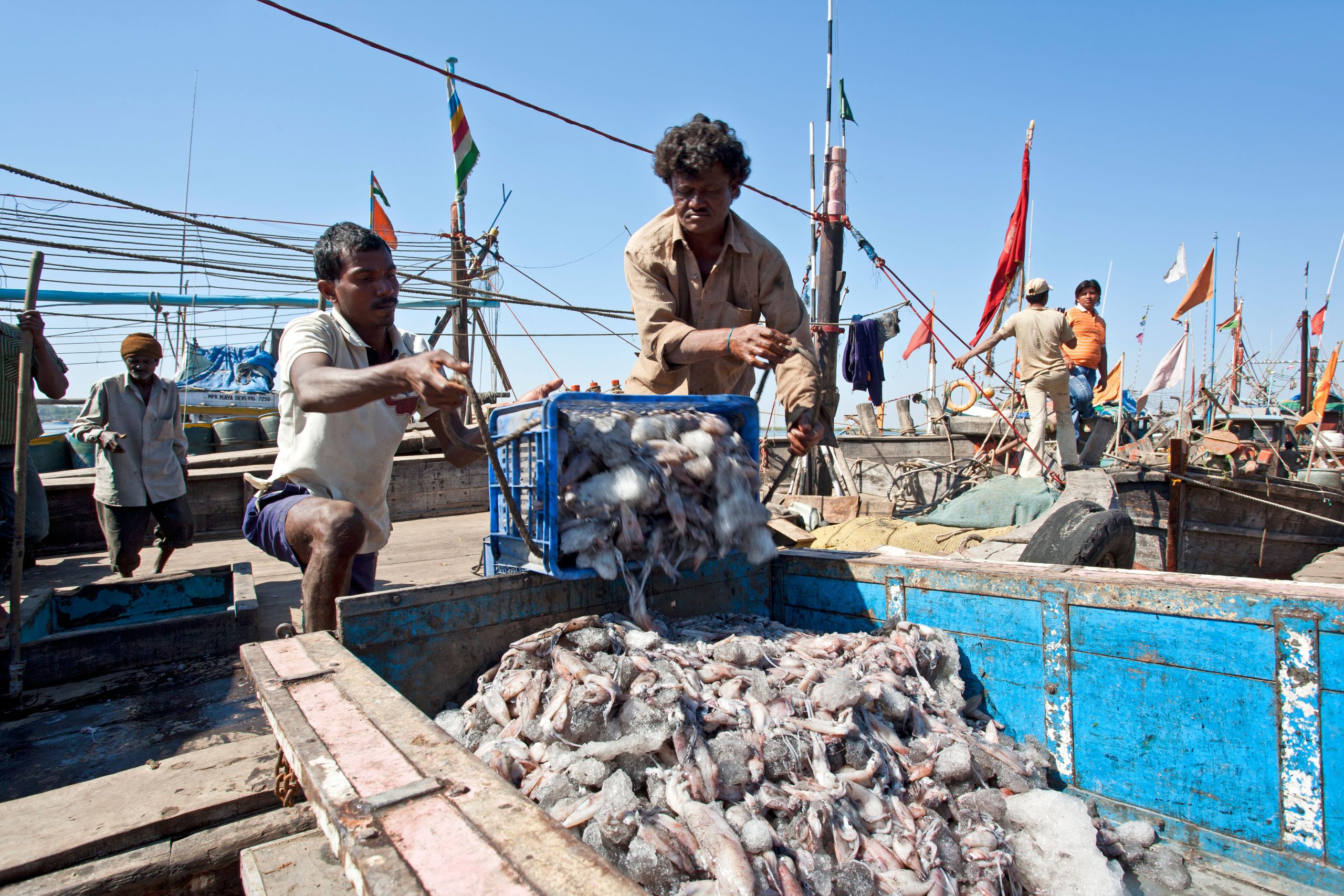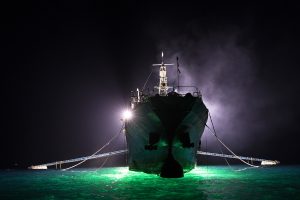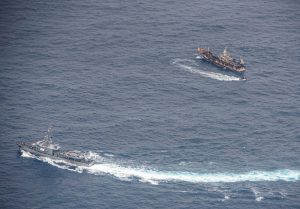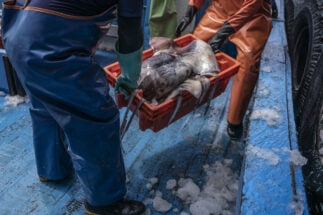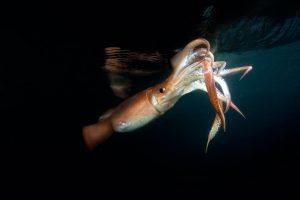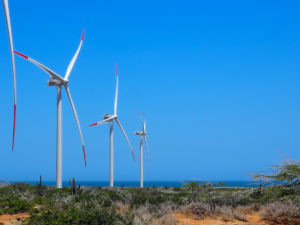In Peru, it goes by pota. In Chile, it’s known as jibia, and in Mexico “the red devil” after its tendency to turn rouge when hooked. In English, it is the Humboldt squid. However you name it, Dosidicus gigas is the most heavily fished of the world’s squid species.
In recent decades, industrial vessels have increasingly targeted this species on the high seas – beyond country’s exclusive economic zones – while regulations have failed to keep pace. The emergence of a squid fishery in the south-east Pacific Ocean has garnered much attention. But it is part of a wider trend in international waters, where such fisheries are now booming in a regulatory vacuum, leaving experts worried for the health of stocks and the larger ocean ecosystem.
“I am concerned about the massive catch volume, the number of vessels going for squid in these various areas,” says Phillip Chou, senior director of global policy at Oceana, an international oceans-focused nonprofit. Meanwhile, Will McCallum, co-executive director of Greenpeace UK, describes squid fishery growth as “one of the most egregious examples of the industrialisation of the high seas”, adding that “it’s happened overnight”.
Squid are invertebrates with an elongated soft body, typically topped with eight arms and two longer tentacles. They are a type of cephalopod mollusc found in every ocean, with at least 290 known species. In the past few decades, the global catch of cephalopods – a class also including cuttlefish and octopus – has risen tenfold, from around 500,000 tonnes annually in 1950 to a peak of 4.85 million tonnes in 2014. The most rapid increases have been in squid fisheries, to the extent that squid now represent a sizeable portion of the overall landings in some ocean regions.
Squid are targeted for human consumption, and in some regions, the increasing catch has coincided with a decline in traditional fisheries, suggesting that squid is becoming a market substitute for fish. In the north-west Pacific, for instance, declines in traditional fisheries, such as Japanese pilchard and Alaskan pollock, have been offset by a boom in cephalopod landings, mostly of squid.
While squid populations aren’t currently classified as endangered, scientists say that a recent rapid uptick in unregulated fishing is putting these stocks at risk. “Squid is very important for ecosystems. It’s not just food for humans, but for everything else in the ocean,” says Alexander Arkhipkin, a senior fisheries scientist at the Falkland Island Fisheries Department.
According to a study published in March in the journal Science Advances, squid fisheries are now extensive, and growing, on the high seas. In the four-year period from 2017 to 2020, the fishing effort of the global squid fleet increased 68%, from 149,000 fishing days per year in 2017 to 251,000 in 2020.
The vessels targeting squid offshore in unregulated areas are mostly industrial squid jiggers. These highly mobile vessels move easily between fishing grounds and stay at sea for long periods, typically three months to a year, to maximise their catch based on seasonal abundance. Vessels flagged to various countries fish these unregulated grounds, but Chinese-flagged vessels dominate the sector both in terms of numbers and hours fished.
According to the recent study, which was led by ocean policy expert Katherine Seto of the University of California, Santa Cruz, 86% of squid fishing effort is now concentrated in unregulated areas, and 92% of that fishing is by Chinese-flagged vessels. “There are increasing efforts, increasing fishing vessels, increasing fishing hours, and they tend to be increasing disproportionately in unregulated spaces,” says Seto.
Regulation lacking
For the most part, squid stocks on the high seas are unregulated. Currently, 17 bodies known as regional fisheries management organisations (RFMOs) have responsibility for overseeing fisheries in international waters. These bodies have a remit to allocate quotas between member states, to reduce bycatch and minimise illicit activity. In practice, however, RFMOs only oversee certain fish stocks or certain areas – tuna in the Pacific, for example, or general fisheries in a defined region such as the north-east Atlantic. The limitation of this system is that it leaves some fisheries, such as squid, and some of the ocean’s richest fishing grounds, with no oversight at all.
On the high seas, four areas are of particular concern for squid: the south-east and north-west Pacific, the south-west Atlantic and the north-west Indian.
In the south-east Pacific, each month, several thousand tonnes of Humboldt squid are harvested off the coasts of Ecuador, Peru and Chile, mostly by large industrial foreign vessels. The landings in this region account for around half of the global annual squid catch, but in recent years the catch per unit of effort (CPUE) of the fleet has declined sharply, suggesting that the stock itself is in trouble.
Catch per unit of effort is total catch divided by fishing effort involved. It may be expressed as kilograms of fish per boat-day, for example. Declines in CPUE can indicate that fish populations are unable to support the level of harvesting imposed on them. Increases can indicate population growth, though CPUE is only as good as the data fed into it.
“In the last two or three years, there are indications that the stock is starting to decline,” says Arkhipkin. A similar sharp decline in CPUE has been noted in the north-west Pacific, where a large industrial fleet targets Japanese flying squid (Todarodes pacificus) and neon flying squid (Ommastrephes bartramii).
In the south-west Atlantic, a fishery for Argentine shortfin squid (Illex argentinus) – a smaller, short-lived species – has emerged in recent years, also attracting foreign industrial vessels, as well as a smaller domestic fleet. Squid now account for 10–40% of the region’s annual landings, the wide range explained in part by the stocks’ sensitivity to environmental conditions. In the north-west Indian, beyond the national waters of Yemen and Oman, squid fisheries – mostly targeting purpleback squid (Sthenoteuthis oualaniensis) – have seen an historically unprecedented expansion in recent years. Between 2015 and 2019, the fleet expanded in size by 830%.
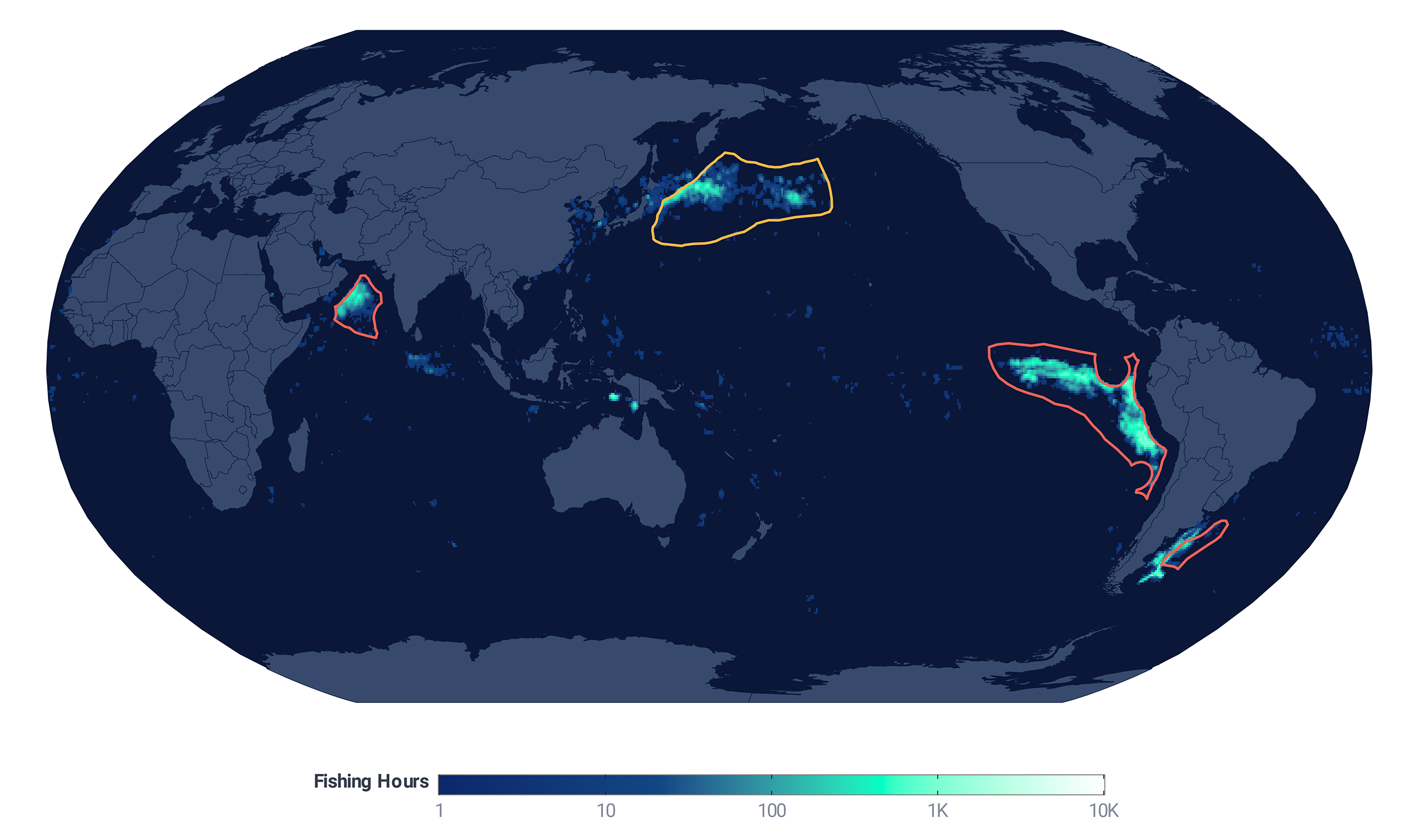
For the most part, the surge in squid fishing is happening outside the jurisdiction of RFMOs, in remote parts of the ocean. In the south-west Atlantic, for instance, where Argentine shortfin squid is targeted, there is no RFMO, a result of the ongoing political dispute over the Falklands/Malvinas. In the absence of an authority that sets rules on the number or size of the vessels, or the amount of catch allowed, a large industrial fleet, both domestic and distant-water, has started fishing this part of the high seas.
In the north-west Indian, squid fisheries are, similarly, expanding in a region without an RFMO. A 2021 report by the international nonprofit Trygg Mat Tracking (TMT) revealed the rapid pace of its expansion since its emergence in 2017 up to 2020, when several non-profits including TMT and Greenpeace, last surveyed the area. They found the fishery mostly comprised Chinese-flagged vessels, with the fleet growing from around 30 vessels in 2017 to 279 in 2020, says senior analyst Eleanor Partridge. The same analysis found that squid fishing in this region now includes squid jiggers and vessels rigged with nets, a situation that places other species at risk. “There’s little or no scrutiny besides the flag state of the vessels,” says McCallum, adding that they observed unreported tuna and sharks among the bycatch.
In some regions, however, the situation is more complicated. In the north-west Pacific, for instance, the sharp decline in CPUE has taken place in spite of the presence of a regional authority. The high seas of the south Pacific, where Humboldt squid is targeted, are also managed by an RFMO, in this case the SPRFMO. In recent years, the body, which operates by consensus among its members – 16 nations plus the EU – has recognised the need to introduce rules to moderate squid fishing.
“There is a recognition that the catch level is unsustainable and can’t continue,” says Barry Weeber of nonprofit Eco NZ, who is an observer at SPRFMO meetings. At its most recent meeting, in February 2023, a number of proposals to monitor and control the fishery were put forward, among them a requirement for vessels to carry fisheries observers onboard by 2028, as well as the introduction of limits on total squid catches. These were all rejected. One measure – a pre-emptive limit on fishing effort – passed, but it’s seen as being insufficiently stringent to reign in the fleet. “It’s a cap in name only,” says Weeber.
Squid sensitivity compounds risk
One argument in favour of fishing squid over other species is that they are short-lived, with huge reproductive potential: the Humboldt squid lives for one to two years and a female can lay a million eggs at a time, and as many as 20 million during her short lifetime. The Argentine shortfin squid and Japanese squid, on the other hand, live for just a year, and a female lays about 750,000 eggs. “They grow, they reproduce, they die. And so they have a very fast renewal rate. In that sense, they are like anchovies,” says Manuel Barange, director of fisheries and aquaculture policy at the UN Food and Agriculture Organization in Rome. He contends that, with a few minor exceptions, most global squid stocks are healthy.
“When it comes to these squid fisheries, we don’t know what we don’t know,” says Seto, pointing out that while monitored stocks might be faring well, the issue with these expanding squid fisheries is that they are neither regulated nor monitored. “We don’t have the data-reporting and the data-sharing arrangements that would help us get a handle on the implications for equity and sustainability,” she says.
Squid are also highly sensitive creatures whose populations can plummet rapidly. Variable environmental conditions, and climate change, impact population success from one year to the next, causing massive fluctuations in catch rates. The worry is that heavy industrial fishing, operating without limits, could place another pressure on squid populations, damaging these species that occupy a vital mid-level role within marine food webs, as both prey and predators. In the south-west Atlantic, for example, cephalopods account for around 38% of fish prey species. In the north-west Indian, where the fishery is expanding most rapidly, squid are an important component of tuna diets.
Fisheries scientist Arkhipkin says that with squid, there’s a real possibility that high fishing pressure “could take out a significant proportion of a small population in a year of low abundance. That could crash the resource with implications for the following year.” Arkhipkin points to the shortfin squid (Illex illecebrosus) off the east coast of Canada and the US as evidence that squid stocks can, in fact, crash. The fishery was heavily exploited in the late 1970s and early 1980s, declining rapidly in the late 1980s, due to fishing pressure as well as oceanographic conditions. “That stock never recovered,” he says.
As well as having implications for ocean health, there is a knock-on effect, for local fishers and diets, of removing species that move between national waters and the high seas. “There’s a genuine food security issue in the north-west Indian Ocean from removing that amount of biomass. Coastal states are relying on these fisheries,” says McCallum.
Ineffective measures
Conservationists point to the exponential rise in unregulated squid fishing as a failure of ocean governance. One option, says Seto, is to strengthen existing RFMOs.
“What we’re hearing from the international community, including the government of China, is concern for squid stocks,” says Seto. “And we’re seeing policies coming down the line that state that concern,” she says.
In 2020, China introduced a new fisheries code containing new laws to be applied to its distant-water fishing fleet. These include China’s first-ever voluntary seasonal closures on the high seas, covering the main spawning grounds of the Humboldt and Argentine shortfin squid – a move that should, in theory, allow their stocks time to reproduce and recover. In 2022, China extended these measures, which now cover the south-west Atlantic, the east Pacific and the north Indian oceans.
The measures have been met with muted enthusiasm by Arkhipkin, who says the closures for Humboldt and Argentine shortfin “coincide with a period when squid are not there anyhow” and are therefore ineffectual. But Wang Songlin, a marine ecologist and president of the Qingdao Marine Conservation Society, says these measures “benefit not only relevant squid stocks, but also hundreds of fish and shellfish species and other marine lives that are either secondary catches or bycatches”. Wang, who is based in China’s Shandong province, says that the measures can also give “seafloor habitats of high conservation value – some of which are breeding grounds of squid – a much-needed break”.
Wang suggests that if other nations implemented similar voluntary measures on the high seas, the result would be more “science-based, constructive and ambitious multinational effort”, which would benefit both the squid fisheries and fishing-dependent communities.
Arkhipkin, meanwhile, would like to see an independent group of scientists produce regular reports on the status of squid stocks and administer warnings, much as the IPCC does on climate. But how to force fishing fleets to heed these warnings is another matter. “It’s a very difficult situation,” he admits. “How to solve it, I’m not sure.”
